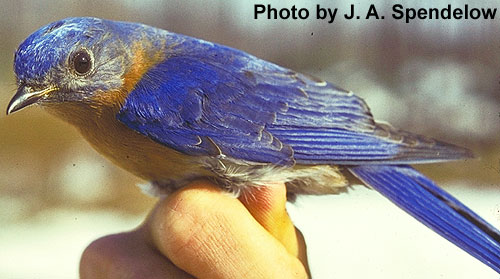Almost as soon as I posted my March 7 report, I saw a
bluebird (
Sialia sialis) and the first Red-wing Blackbird (
Agelaius phoeniceus) of the Spring. Just before the rains began, I also saw a half-dozen
killdeer (
Charadrius vociferus) in the fields down along the South Branch floodplain. I'll bet many are busy relocating their nests this week.
If you spent time outside or even near a window this week, and realize you're feeling a little better about things, it likely has something to do with both the temperature and the length of daylight. In all vertebrate animals, signals from your retina from an increase in light affect your pineal gland, which is shaped like a very small pine cone, about the size of a grain of rice. As you can see in the image below, it's located near the center of the brain.

The pineal gland is a small endocrine gland in fish, amphibians, reptiles, birds and mammals that produces melatonin, which is a hormone that affects both daily and seasonal functions of our lives. The melatonin and other biochemical signals it produces affect behavior, migration, shedding, antler loss, and a wide variety of other functions and behaviors. It may affect humans less than other animals because we have regular estrous cycles (come into heat) throughout the year; and because, of course, we use technology to alter our "photoperiod" of available light.
The pineal gland is made up of four or more types of cells, and some of those cells in non-humans strongly resemble retinal cells, leading some evolutionary biologists to suggest a link to the photoreceptors in more primitive animals. In short, the pineal gland may help animals from being fooled by unseasonably warm temperatures that might lead to certain behaviors or cycles beginning too early, resulting in premature migrations, reduced reproduction or lower birthweights, etc.
Most of you have already noticed
daffodil bulbs (
Narcissus spp.) breaking the surface.
Crocuses are blooming (most are
Crocus tommasinianus, I think), among
wild garlic (
Allium vineale) and
wild onion (
Allium canadense). Wild onion and wild garlic are closely related; the easiest way to distinguish them is to know that wild garlic's leaves are hollow and wild onion's are not. All members of the
Allium family (garlic, onions, leeks, shallots, etc.) give me instant hiccups, so I'll rely on one of you to tell us which are best for cooking.
We planted most of our
hibiscus seeds in late November and early December, but spread the remainder just before the flooding last week. I hope the folks downstream enjoy them in July and August.
Swamp rose mallow (
Hibiscus moscheutos) is the most common hibiscus in Hampshire County, and has white flowers the size of small dinner plates. We also planted
H. laevis (formerly
H. militaris) which is usually pink with a purple center; and we planted
H. lasiocarpos, which some think is a subspecies of
H. moschuetos preferring wetter soils.
 Swamp rose mallow
Swamp rose mallow (
Hibiscus moscheutos)
Birds have begun singing prominantly in the mornings, and I hope you'll tell me which you see and hear singing. This time of the year that singing is mostly territorial, followed by mating later in the Spring. I've been seeing
crows (
Corvus brachyrhynchos) exhibiting territorial aggression.
Flooding has receded, and while the river banks are scarred, take notice of which river bank features contributed to erosion or were eroded, and which river features resulted in sediment deposits. Predicting erosion is often easier than predicting where sediments will be deposited, but engineering solutions for controlling either are often counterintuitive. Fortunately, we have knowledgeable local DNR specialists who are happy to give advice.
Because of the overwhelming saturation of wetlands and bottomlands, I'm very interested in when you begin hearing spring peepers. Use the online form!
tiny.cc/hampshireoutdoors







